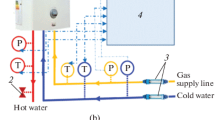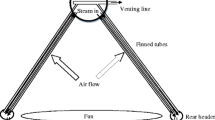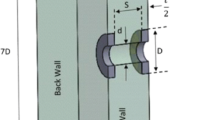Abstract
The heat transfer and mass transfer fin efficiencies were analyzed numerically to show that popular models for heat transfer fin efficiency for circular fins are not always reasonable. The numerical results show that the effective heat transfer area of a circular fin increases several times faster than that of a straight fin for the same tube radius. Then, a simple but accurate heat transfer fin efficiency model was developed and verified by numerical results for a wide range of fin designs. This model predicts the heat transfer fin efficiency with absolute errors of less than 1%. The heat transfer and mass transfer fin efficiencies were found to be quite different for typical air flow with low relative humidity. Thus, these two fin efficiencies should not be assumed to be equal and a mass transfer fin efficiency model was developed, based on the heat transfer fin efficiency model. These heat transfer and mass transfer fin efficiencies are very useful for more accurate prediction for a wide range of practical applications.
Similar content being viewed by others
References
Huzayyin A S, Nada S A, Elattar H F. Air-side performance of a wavy-finned-tube direct expansion cooling and dehumidifying air coil. Int J Refrig, 2007, 30(2): 230–244
Pirompugd W, Wang C C, Wongwises S. Finite circular fin method for wavy fin and tube heat exchangers under fully and partially wet surface conditions. Int J Heat Mass Tran, 2008, 51(15–16): 4002–4017
Wang C C, Lee W S, Sheu W J, et al. A comparison of the airside performance of the fin and tube heat exchangers in wet conditions: with and without hydrophilic coating. Appl Therm Eng, 2002, 22(3): 267–278
Liang S Y, Wong T N, Nathan G K. Comparison of one-dimensional and two-dimensional models for wet-surface fin efficiency of a plate fin tube heat exchanger. Appl Therm Eng, 2000, 20(10): 941–962
SalahEi-Din M M. Performance Analysis of partially-wet fin assembly. Appl Therm Eng, 1998, 18(5): 337–349
Liang S Y, Wong T N. Experimental validation of model predictions on evaporator coils with an emphasis on fin efficiency. Int J Therm Sci, 2010, 49(1): 187–195
Liu J, Wei W J, Ding G L, et al. Development of study on heat transfer and friction characteristics of fin and tube heat exchanger-experimental study. J Refrig, 2003, (3): 25–30
Gardner K A. Efficiency of extended surfaces. Trans ASME, 1945, 67: 621–631
Barker J J. The efficiency of composite fins. NS&E, 1958, 3: 300–312
Naphon P. Study on the heat transfer characteristics of the annular fin under dry-surface, partially wet-surface and fully wet-surface conditions. Int Commun Heat Mass, 2006, 33(1): 112–121
Sparrow E M, Charmchi M. Laminar heat transfer in an externally finned circular tube. J Heat Transfer, 1980, 102(12): 605–611
Liu X H, Zhang H. A problem of fin efficiency in engineering calculation. RAC, 2008, 8(2): 25–28
McQuiston F C. Fin efficiency with combined heat and mass transfer, ASHRAE Trans Part 1, 1975, 81(1): 350–355
Jouhara H, Axcell B P. Modelling and simulation techniques for forced convection heat transfer in heat sinks with rectangular fins. Simul Model Pract Th, 2009, 17(5): 871–882
Hong K T, Webb R. L. Calculation of fin efficiency for wet and dry fins. HVAC&R Res, 1996, 2(1): 27–1
Maheswaran U, Sekhar S C. Evaluation of concepts of fin efficiency using Monte Carlo simulation method. Int J Heat Mass Tran, 2006, 49(9–10): 1643–1646
Kraus A D, Kern D Q. Extended Surface Heat Transfer. New York: McGraw Hill, 1972. 439–525
Liu W, Liu Z C, Wang Y S, et al. Flow mechanism and heat transfer enhancement in longitudinal-flow tube bundle of shell-and-tube heat exchanger. Sci China Ser E-Tech Sci, 2009, 52(10): 2952–2959
Guo J F, Xu M T, Cheng L. Principle of equipartition of entransy dissipation for heat exchanger design. Sci China Ser E-Tech Sci, 2010, 53(5): 1309–1314
Schmidt T E. Heat transfer calculations for extended surfaces. Refrig Eng, 1949, 43: 39–51
Comini G, Savino S. Latent and sensible heat transfer in air-cooling application. Int J Numer Method H, 2007, 17(6): 608–627
Liang S Y, Wong T N. Experimental validation of model predictions on evaporator coils with an emphasis on fin efficiency. Int J Therm Sci, 2010, 49(1): 187–195
Lin C N, Jang J Y. A two-dimensional fin efficiency analysis of combined heat and mass transfer in elliptic fins. Int J Heat Mass Tran, 2002, 45(18): 3839–3847
Wang J, Hihara E. Prediction of air coil performance under partially wet and totally wet cooling conditions using equivalent dry-bulk-temperature method. Int J Refrig, 2003, 26(3): 293–301
Pirompugd W, Wang C C, Wongwises S. Finite circular fin method for heat and mass transfer characteristics for plain fin and tube heat exchangers under fully and partially wet surface conditions. Int J Heat Mass Tran, 2007, 50(3–4): 552–565
Pu H, Ding G L, Ma X K, et al. Long-term performance of air-side heat transfer and pressure drop for finned tube evaporators of air conditioners under intermittent operation conditions. Int J Refrig, 2010, 33(1): 107–115
Wang C C. On the heat and mass analogy of fin-and-tube heat exchangers. Int J Heat Mass Tran, 2008, 51(7–8): 2055–2059
Pu H, Ding G L, Ma X K, et al. Effects of biofouling on air-side heat transfer and pressure drop for finned tube heat exchangers. Int J Refrig, 2009, 32(5): 1032–1040
Ma X K, Ding G L, Zhang Y M, et al. Airside heat transfer and friction characteristics for enhanced fin-and-tube heat exchanger with hydrophilic coating under wet conditions. Int J Refrig, 2007, 30(7): 1153–1167
Hong T K, Webb R L. Calculation of fin efficiency for wet and dry fins. HVAC&R Res, 2006, 2(1): 27–41
Threlkeld J L. Thermal Environmental Engineering. 2nd ed. Englewood Cliffs, New Jersey: Prentice-Hall, 1970. 263–264
Author information
Authors and Affiliations
Corresponding author
Rights and permissions
About this article
Cite this article
Li, C., Li, J. & Zhang, H. Airside fin efficiencies for finned-tube heat exchangers with forced convection. Sci. China Technol. Sci. 54, 2468–2474 (2011). https://doi.org/10.1007/s11431-011-4412-2
Received:
Accepted:
Published:
Issue Date:
DOI: https://doi.org/10.1007/s11431-011-4412-2




